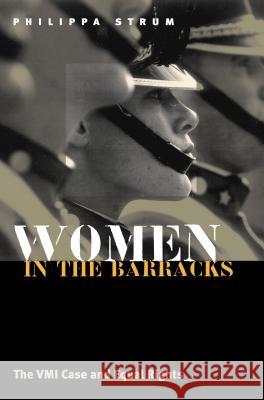Women in the Barracks: The VMI Case and Equal Rights » książka
topmenu
Women in the Barracks: The VMI Case and Equal Rights
ISBN-13: 9780700613366 / Angielski / Miękka / 2002 / 428 str.
In June 2001, there was a decidedly new look to the graduating class at Virginia Military Institute. For the first time ever, the line of graduates who received their degrees at the "West Point of the South" included women who had spent four years at VMI.
For 150 years, VMI had operated as a revered, state-funded institution--an amalgam of Southern history, military tradition, and male bonding rituals--and throughout that long history, no one had ever questioned the fact that only males were admitted. Then in 1989 a female applicant complained of discrimination to the Justice Department, which brought suit the following year to integrate women into VMI. In a book that poses serious questions about equal rights in America, Philippa Strum traces the origins of this landmark case back to VMI's founding, its evolution over fifteen decades, and through competing notions about women's proper place. Unlike most works on women in military institutions, this one also provides a complete legal history--from the initial complaint to final resolution in United States v. Virginia--and shows how the Supreme Court's ruling against VMI reflected changing societal ideas about gender roles. At the heart of the VMI case was the "rat line": a ritualized form of hazing geared toward instilling male solidarity. VMI claimed that its system of toughening individuals for leadership was even more stringent than military service and that the system would be destroyed if the Institute were forced to accommodate women. Strum interviewed lawyers from Justice and VMI, heads of concerned women's groups, and VMI administrators, faculty, and cadets to reconstruct the arguments in this important case. She was granted interviews with both Justice Ginsburg, author of the majority opinion, and Justice Scalia, the lone dissenter on the bench, and meticulously analyzes both viewpoints. She shows how Ginsburg's opinion not only articulated a new constitutional standard for institutions accused of gender discrimination but also represented the culmination of gender equality litigation in the twentieth century. Women in the Barracks is a case study that combines both legal and cultural history, reviewing the long history of male elitism in the military as it explores how new ideas about gender equality have developed in the United States. It is an engrossing story of change versus tradition, clear and accessible for general readers yet highly instructive and valuable for students and scholars. Now as questions continue to loom concerning the role of state funding for single-sex education, Strum's book squarely addresses competing notions of women's place and capabilities in American society.










